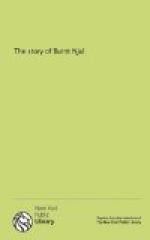With the change of faith and conversion of the Icelanders to Christianity, writing, and the materials for writing, first came into the land, about the year 1000. There is no proof that the earlier or Runic alphabet, which existed in heathen times, was ever used for any other purposes than those of simple monumental inscriptions, or of short legends on weapons or sacrificial vessels, or horns and drinking cups. But with the Roman alphabet came not only a readier means of expressing thought, but also a class of men who were wont thus to express themselves.... Saga after Saga was reduced to writing, and before the year 1200 it is reckoned that all the pieces of that kind of composition which relate to the history of Icelanders previous to the introduction of Christianity had passed from the oral into the written shape. Of all those Sagas, none were so interesting as Njal, whether as regarded the length of the story, the number and rank of the chiefs who appeared in it as actors, and the graphic way in which the tragic tale was told. As a rounded whole, in which each part is finely and beautifully polished, in which the two great divisions of the story are kept in perfect balance and counterpoise, in which each person who appears is left free to speak in a way which stamps him with a character of his own, while all unite in working towards a common end, no Saga had such claims on public attention as Njala, and it is certain none would sooner have been committed to writing. The latest period, therefore, that we can assign as the date at which our Saga was moulded into its present shape is the year 1200....
It was a foster-father’s duty, in old times, to rear and cherish the child which he had taken from the arms of its natural parents, his superiors in rank. And so may this work, which the translator has taken from the house of Icelandic scholars, his masters in knowledge, and which he has reared and fostered so many years under an English roof, go forth and fight the battle of life for itself, and win fresh fame for those who gave it birth. It will be reward enough for him who has first clothed it in an English dress if his foster-child adds another leaf to that evergreen wreath of glory which crowns the brows of Iceland’s ancient worthies.
BROAD SANCTUARY.
Christmas Eve, 1860.
It will be seen that in most cases the names of places throughout the Saga have been turned into English, either in whole or in part, as “Lithend” for “Lfaethrendi,” and “Bergthorsknoll” for “Bergthorshvol”. The translator adopted this course to soften the ruggedness of the original names for the English reader, but in every case the Icelandic name, with its English rendering, will be found in the maps. The surnames and nicknames have also been turned into English—an attempt which has not a little increased the toil of translation. Great allowance must be made for these renderings, as those nicknames often arose out of circumstances of




